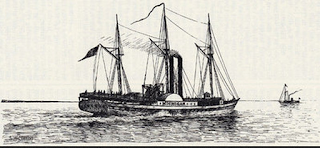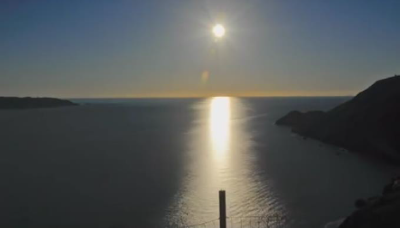Contents 61-70
61. On a spherical Earth buildings near the horizon would noticeably tilt backwards

“If the Earth were actually a big ball 25,000 miles in circumference, the horizon would be noticeably curved even at sea-level, and everything on or approaching the horizon would appear to tilt backwards slightly from your perspective. Distant buildings along the horizon would all look like leaning towers of Piza falling away from the observer. A hot-air balloon taking off then drifting steadily away from you, on a ball-Earth would slowly and constantly appear to lean back more and more the farther away it flew, the bottom of the basket coming gradually into view as the top of the balloon disappears from sight. In reality, however, buildings, balloons, trees, people, anything and everything at right angles to the ground/horizon remains so regardless the distance or height of the observer”
62. The Bedford Levels experiment proved things did not disappear over the horizon as they would on a spherical Earth

“Samuel Rowbotham’s experiments at the Old Bedford Level proved conclusively the canal’s water to be completely flat over a 6 mile stretch. First he stood in the canal with his telescope held 8 inches above the surface of the water, then his friend in a boat with a 5 foot tall flag sailed the 6 miles away. If Earth were a ball 25,000 miles in circumference the 6 mile stretch of water should have comprised an arc exactly 6 feet high in the middle, so the entire boat and flag should have ultimately disappeared, when in fact the entire boat and flag remained visible at the same height for the entire journey.”
63. An experiment involving flags lined up on on a shoreline to prove that the Earth is flat

“In a second experiment Dr. Rowbotham affixed flags 5 feet high along the shoreline, one at every mile marker. Then using his telescope mounted at 5 feet just behind the first flag looked over the tops of all 6 flags which lined up in a perfectly straight line. If the Earth were a ball 25,000 miles in circumference the flags should have progressively dipped down after the first establishing line of sight, the second would have descended 8 inches, 32 inches for the third, 6 feet for the fourth, 10 feet 8 inches for the fifth, and 16 feet 8 inches for the sixth.”
64. An experiment using poles and string appeared to show a ship travelling horizontally which could not happen if the Earth was a sphere

“Quoting “Earth Not a Globe!” by Samuel Rowbotham, “It is known that the horizon at sea, whatever distance it may extend to the right and left of the observer on land, always appears as a straight line. The following experiment has been tried in various parts of the country. At Brighton, on a rising ground near the race course, two poles were fixed in the earth six yards apart, and directly opposite the sea. Between these poles a line was tightly stretched parallel to the horizon. From the center of the line the view embraced not less than 20 miles on each side making a distance of 40 miles. A vessel was observed sailing directly westwards; the line cut the rigging a little above the bulwarks, which it did for several hours or until the vessel had sailed the whole distance of 40 miles. The ship coming into view from the east would have to ascend an inclined plane for 20 miles until it arrived at the center of the arc, whence it would have to descend for the same distance. The square of 20 miles multiplied by 8 inches gives 266 feet as the amount the vessel would be below the line at the beginning and at the end of the 40 miles.””
65. By guessing the height and speed of a steamer Rowbotham thought that the steamer would have disappeared from view sooner on a spherical Earth

“Also Quoting Dr. Rowbotham, “On the shore near Waterloo, a few miles to the north of Liverpool, a good telescope was fixed, at an elevation of 6 feet above the water. It was directed to a large steamer, just leaving the River Mersey, and sailing out to Dublin. Gradually the mast-head of the receding vessel came nearer to the horizon, until, at length, after more than four hours had elapsed, it disappeared. The ordinary rate of sailing of the Dublin steamers was fully eight miles an hour; so that the vessel would be, at least, thirty-two miles distant when the mast-head came to the horizon. The 6 feet of elevation of the telescope would require three miles to be deducted for convexity, which would leave twenty-nine miles, the square of which, multiplied by 8 inches, gives 560 feet; deducting 80 feet for the height of the main-mast, and we find that, according to the doctrine of rotundity, the mast-head of the outward bound steamer should have been 480 feet below the horizon. Many other experiments of this kind have been made upon sea-going steamers, and always with results entirely incompatible with the theory that the earth is a globe.”
66. Dr. Rowbotham conducted some experiments using telescopes, spirit levels, sextants and theodolites. Dubay repeats Rowbotham’s claim these prove the Earth is flat.

“Dr. Rowbotham conducted several other experiments using telescopes, spirit levels, sextants and “theodolites,” special precision instruments used for measuring angles in horizontal or vertical planes. By positioning them at equal heights aimed at each other successively he proved over and over the Earth to be perfectly flat for miles without a single inch of curvature. His findings caused quite a stir in the scientific community and thanks to 30 years of his efforts, the shape of the Earth became a hot topic of debate around the turn of the nineteenth century.”
67. From a height of 100 feet Great Orme's Head is visible from Douglas Harbour which is not possible on a spherical Earth

“The distance across the Irish Sea from the Isle of Man’s Douglas Harbor to Great Orm’s Head in North Wales is 60 miles. If the Earth was a globe then the surface of the water between them would form a 60 mile arc, the center towering 1944 feet higher than the coastlines at either end. It is well-known and easily verifiable, however, that on a clear day, from a modest altitude of 100 feet, the Great Orm’s Head is visible from Douglas Harbor. This would be completely impossible on a globe of 25,000 miles. Assuming the 100 foot altitude causes the horizon to appear approximately 13 miles off, the 47 miles remaining means the Welsh coastline should still fall an impossible 1472 feet below the line of sight!”
68. The Philadelphia skyline should not be visible from Apple Pie Hill on a spherical Earth

“The Philadelphia skyline is clearly visible from Apple Pie Hill in the New Jersey Pine Barrens 40 miles away. If Earth were a ball 25,000 miles in circumference, factoring in the 205 foot elevation of Apple Pie Hill, the Philly skyline should remain well-hidden beyond 335 feet of curvature.”
69. From Bear Mountain the New York City skyline should not be visible on a spherical Earth

“The New York City skyline is clearly visible from Harriman State Park’s Bear Mountain 60 miles away. If Earth were a ball 25,000 miles in circumference, viewing from Bear Mountain’s 1,283 foot summit, the Pythagorean Theorem determining distance to the horizon being 1.23 times the square root of the height in feet, the NYC skyline should be invisible behind 170 feet of curved Earth.”
70. The skylines of New York and Philadelphia should not be visible from Washington's Rock on a spherical Earth

“From Washington’s Rock in New Jersey, at just a 400 foot elevation, it is possible on a clear day to see the skylines of both New York and Philadelphia in opposite directions at the same time covering a total distance of 120 miles! If Earth were a ball 25,000 miles in circumference, both of these skylines should be hidden behind over 800 feet of Earth’s curvature.”



Comments
Post a Comment